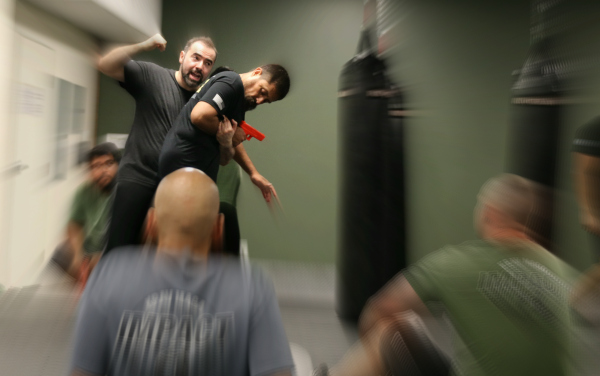

Krav Maga: more than just Self-Defense
We occasionally get asked a strange question: “Is Krav Maga only for self-defense?” This question often leaves me at a loss as to how to address it. But over the years of being asked this and similar questions, I came to the realization that the people are possibly enquiring about a number of things all of which we will briefly address here.
The first interpretation of this question can stem from the misconception that people have in relations to the nature of self-defense. Some people believe that self-defense is like a magic potion, that once consumed will allow you to get out from any violent situation with one or two moves that require little to no effort and do not require any need for offensive measures. But of course this is not true, any violent action requires an equal (if not more) violent counteraction with strong and decisive counterstriking and aggressive mindset and behavior. Of course this involves proper training where the technical, physical and mental aspects of fighting are constantly taught, sharpened, reinforced and tested under variable degrees of stress. This is the kind of Krav Maga training we provide at Impact. Obviously any student that learns to defend themselves or loved ones can use the same combat skills for more nefarious deeds such as starting fights, attacking people, intentionally hurting others, etc. But we do not tolerate this behavior and even this type of mindset, and make it very clear right from the get-go. So if anyone’s goal is to learn Krav Maga for its offensive capabilities with intent on hurting others, then our school is not for them. Therefore, looking at it from this perspective, you can say that Krav Maga training we provide is intended solely for self-defense purposes.
The second interpretation of the above question can relate to the comparison of Krav Maga to other martial arts. Most martial arts are separated into three categories: art and style; sports and competition; combat and self-defense. Although most martial arts have had their origins in combat, very few are still applicable for the modern day. You can imagine that these days the need to learn how to defend against a swordsman using your own sword or long staff is not a priority, but defending against a pistol threat may be of more value. Hence, some older forms of traditional martial arts have evolved into exactly that, an art, where practitioners train for the sake of form, style and physical and mental fitness.
Other systems have expanded into the realm of competition to see how their style of fighting measures up against another, or to see how martial artists from one school do against that of a competing dojo. To protect the competitors, rules had to be instated and refined over time to ensure minimum harm to the athletes. But introduction of rules also abandoned the original combat mentality of the system and forced the training to be more tailored towards wining tournaments and less towards warfare and self-defense. Perfect example is mixed martial arts (MMA); from the days that Ultimate Fighting Championship (UFC) first came into existence in the 90s, to over 20 years later today, the rules have changed significantly and the style of fighting has too been significantly altered as a result. Originally only two rules existed: no biting and no eye gouging. Now UFC has expanded the rules to athletes having to wear protective gloves, no strikes to the groin or to the back of the head, no kicks or knees to the head of a downed opponent, and a few others. Plus never in the history of UFC has there been a sanctioned event where athletes had to fight more than one opponent, or armed opponents, or anything else that is more likely to happen in a combat/self-defense scenario. Of course these MMA athletes are great fighters, but their training has focused on controlled violence; one that they will face in the octagon and not in the street where there are no rules of combat, or code of conduct among participants.
That brings us to the last form of martial arts that focus on modern combat and self-defense. Krav Maga falls into this category. It is designed to teach people how to deal with violent encounters from attackers that don’t play by any rules. Although Krav Maga incorporates elements of other fighting styles, it does so in a way that doesn’t compete with the mindset of the system; do what is needed to neutralize the attacker(s) and escape with minimal harm to you and loved ones. Hence we teach how to defend against attackers armed with modern weapons, multiple attackers, fighting from position of disadvantage when you least expect to be attacked, in a car, standing, sitting, and on the ground and much more.
So to answer the question whether Krav Maga focuses only on self-defense, the answer from the perspective of comparison to other martial arts would be yes. Therefore if your goal is to become an MMA fighter or a competitive boxer, you would be better suited to study that particular discipline. But if your goal is to learn lifesaving fighting skills, then Krav Maga is the right choice for you. As far as the additional benefits that other martial arts have, Krav Maga has them too. Fitness is definitely a big component of the training. So you can expect to get physically stronger while training with us. Comradery and friendship among students is another huge benefit that training Krav Maga brings. And mental strength and confidence knowing that you have the skills needed to handle yourselves is another gain of Krav Maga training. So although our immediate focus with teaching Krav Maga is to make people safer, we see improvements in all aspects of their lives. Hence Krav Maga is more than just self-defense, it’s a lifestyle.
